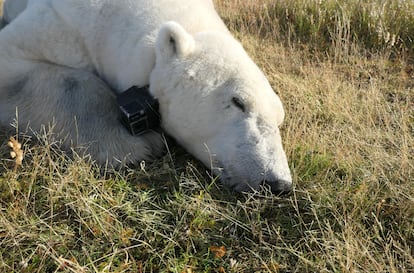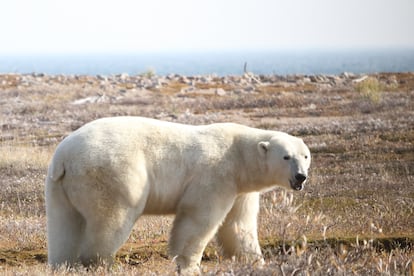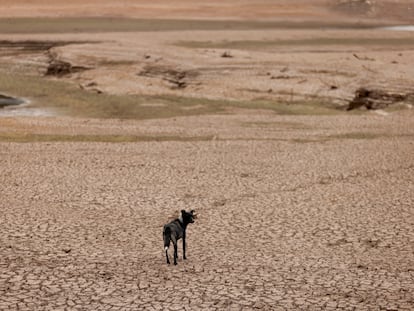Polar bears’ desperate struggle to find food in a melting Arctic
A new study finds that the animals are coping with the risk of starvation from global warming by swimming long distances and scavenging, but with little success

In a world where climate change is rapidly changing natural habitats, polar bears have become a key symbol of the fight for survival. Summers are getting longer, global temperatures are rising, and there is less and less ice. When the frozen blocks of the Arctic disappear, bears spend more time on land, where it is difficult to find food, as their traditional hunting strategies that take advantage of the sea ice are less effective. A study published on Tuesday in Nature Communications looks at how the remaining 25,000 polar bears left on the planet are fighting to starve off starvation.
In the period of late spring and early summer, polar bears use sea ice as a hunting platform. They feed mainly on seals that are giving birth and weaning their pups in the same season. When the ice melts, the Arctic giants have to slow down as much as possible to conserve energy. A team of scientists, led by wildlife biologist Anthony Pagano of the United States Geological Survey, observed polar bears up close for three weeks over the summer. To do this, they placed collars equipped with cameras and GPS on 20 bears in western Hudson Bay, Manitoba (Canada). In this area, the polar bear population has decreased by around 30% since 1987. The ice-free period has increased by three weeks since 1979, keeping bears on land for approximately 130 days in the past decade.
After analyzing the images, they discovered that the polar bears used different tactics to find food and maintain their energy reserves, including scavenging and resting at similar levels as grizzly bears when they enter hibernation. Seventy percent of the polar bears who were active ate terrestrial foods such as berries, herbs and bird carcasses. Three bears swam long distances to find food in the water and although two of them found beluga and seal remains, they were unable to eat the remains while swimming or bring it to land.
Irrespective of the feeding or rest strategy, the polar bears’ body mass fell consistently, and 19 of the 20 animals lost an average of 1 kilogram per day. “More time stranded on land means greater risk of starvation for polar bears,” says Pagano.
“Neither strategy will allow polar bears to exist on land beyond a certain amount of time. Even those bears that were foraging lost weight at the same rate as those that were resting,” adds Charles Robbins, the director of the Bear Center at Washington State University, who co-authored the study.
It has been speculated that polar bears could adapt to ice-free seasons by searching for terrestrial food, but the study shows that such food is not easy to find, and does not provide them with enough nutrients or energy, leading them to starve.
David Nogués Bravo, a macroecologist at the Center for Macroecology, Evolution and Climate at the University of Copenhagen, who did not participate in the study, explains that the lack of food “reduces the probability of maintaining generational replacement” and adds that “terrestrial foods gave them some energy benefit, but ultimately they had to expend more energy to access those resources.”

The ice that covers the Arctic reaches its minimum every September, and the ice coverage is smaller and smaller every year. According to NASA data, based on satellite imaging, the polar cap has decreased in size at a rate of 12.6% each decade since 1980. A 2023 study supported by NASA and ESA satellite observations predicts that the first ice-free September will arrive between 2030 and 2050. And if greenhouse emissions are not reduced, the Arctic region will be ice-free for up to half the year by 2100.
The study’s findings have important implications for polar bear conservation and the possible repercussions for Arctic marine and terrestrial ecosystems. If polar bears presence are hunting for longer periods of time in terrestrial areas, this will have indirect impacts on other species such as birds, Nogués explains. “Bears are able to eat dozens of eggs in a short time and reduce the probability that those bird populations will survive,” he adds.
While it is not news that the polar bears are in serious danger of extinction, what is surprising is the massive decline in cubs and the starvation faced by adults due to melting sea ice. “I’ve seen polar bears in the Arctic and it’s a sobering sight to witness the path of this species towards its probable functional extinction in the not too distant future,” says Nogués, who stresses that it is important to keep in mind that “the biodiversity crisis and the climate crisis are not two different crises, but two sides of the same coin.”
Sign up for our weekly newsletter to get more English-language news coverage from EL PAÍS USA Edition
Tu suscripción se está usando en otro dispositivo
¿Quieres añadir otro usuario a tu suscripción?
Si continúas leyendo en este dispositivo, no se podrá leer en el otro.
FlechaTu suscripción se está usando en otro dispositivo y solo puedes acceder a EL PAÍS desde un dispositivo a la vez.
Si quieres compartir tu cuenta, cambia tu suscripción a la modalidad Premium, así podrás añadir otro usuario. Cada uno accederá con su propia cuenta de email, lo que os permitirá personalizar vuestra experiencia en EL PAÍS.
¿Tienes una suscripción de empresa? Accede aquí para contratar más cuentas.
En el caso de no saber quién está usando tu cuenta, te recomendamos cambiar tu contraseña aquí.
Si decides continuar compartiendo tu cuenta, este mensaje se mostrará en tu dispositivo y en el de la otra persona que está usando tu cuenta de forma indefinida, afectando a tu experiencia de lectura. Puedes consultar aquí los términos y condiciones de la suscripción digital.
More information
Archived In
Últimas noticias
Most viewed
- Reinhard Genzel, Nobel laureate in physics: ‘One-minute videos will never give you the truth’
- Oona Chaplin: ‘I told James Cameron that I was living in a treehouse and starting a permaculture project with a friend’
- Pablo Escobar’s hippos: A serious environmental problem, 40 years on
- Charles Dubouloz, mountaineering star, retires at 36 with a farewell tour inspired by Walter Bonatti
- Why we lost the habit of sleeping in two segments and how that changed our sense of time











































